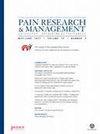Antinociceptive Effects and Interaction Mechanisms of Intrathecal Pentazocine and Neostigmine in Two Different Pain Models in Rats
IF 2.5
3区 医学
Q2 CLINICAL NEUROLOGY
引用次数: 3
Abstract
Background Pentazocine produces a wide variety of actions in the treatment of perioperative analgesia. Neostigmine is a cholinesterase inhibitor used to antagonize the residual effects of muscle relaxants and also produces an analgesic effect. Objectives To investigate the analgesic effects of intrathecally injected pentazocine and neostigmine and their interaction. Methods Sprague–Dawley rats were used to test the analgesic effect of pentazocine and neostigmine using the paw formalin pain model and the incision mechanical allodynia model. Pentazocine (3, 10, 30, and 100 μg), neostigmine (0.3, 1, 3, and 10 μg) or a pentazocine-neostigmine mixture were separately injected to evaluate their antinociceptive effects alone on the treatment groups. The corresponding control group received an intrathecal injection containing the same volume of saline. The formalin pain test, or the plantar incision pain behavior test were performed 30 minutes later. Isobolographic analysis was used to evaluate the interaction between pentazocine and neostigmine. Intrathecally administered selective mu-opioid receptor antagonist CTAP, selective kappa-opioid receptor antagonist nor-Binaltorphimine (nor-BNI), nonselective opioid receptor antagonist naloxone, and muscarinic acetylcholine receptor antagonist atropine were also used to test the possible interaction mechanism. These antagonists were used 30 minutes before the pentazocine and neostigmine mixtures which were intrathecally injected. Results Intrathecally administered pentazocine (3, 10, 30, and 100 μg) and neostigmine (0.3, 1, 3, and 10 μg) alone had a marked dose-related impact on suppressing the biphasic responses in the formalin test. Pentazocine (3, 10, 30, and 100 μg) and neostigmine (0.3, 1, 3, and 10 μg) alone attenuated the mechanical allodynia in a plantar incision model in a dose-dependent manner. Isobolographic analysis revealed that the mixture of intrathecal pentazocine and neostigmine synergistically decreased both phase I and II activity in the formalin test and mechanical allodynia in the plantar incision model. Pretreatment of intrathecally administered nor-BNI, naloxone, atropine, but not CTAP, antagonized the analgesic effect of the pentazocine-neostigmine mixture. Conclusions All of these results suggest that the combined application of pentazocine and neostigmine is an effective way to relieve pain from formalin and acute incision mechanical allodynia. The synergistic effect between pentazocine and neostigmine is mostly attributed to the kappa-opioid receptor and the cholinergic receptor in the spinal cord.鞘内注射戊唑嗪和新斯的明对两种不同疼痛模型大鼠的抗伤害感受作用及其相互作用机制
背景戊唑嗪在围手术期镇痛治疗中具有多种作用。新斯的明是一种胆碱酯酶抑制剂,用于对抗肌肉松弛剂的残留作用,也产生镇痛作用。目的探讨鞘内注射戊唑嗪和新斯的明的镇痛效果及其相互作用。方法采用Sprague-Dawley大鼠建立足部福尔马林疼痛模型和切口机械异常痛模型,观察戊唑嗪和新斯的明对大鼠的镇痛作用。治疗组分别注射戊唑嗪(3、10、30、100 μg)、新斯的明(0.3、1、3、10 μg)或戊唑嗪-新斯的明合剂,观察其单独抗伤感受效果。对照组给予等量生理盐水鞘内注射。30分钟后进行福尔马林疼痛试验或足底切口疼痛行为试验。采用等密度分析法评价了戊唑嗪与新斯的明的相互作用。鞘内给药选择性阿片受体拮抗剂CTAP、选择性阿片受体拮抗剂非- binaltorphine (no - bni)、非选择性阿片受体拮抗剂纳洛酮和毒蕈碱乙酰胆碱受体拮抗剂阿托品也被用来测试可能的相互作用机制。使用这些拮抗剂30分钟后,将戊唑嗪和新斯的明混合物鞘内注射。结果鞘内单独给药戊唑嗪(3、10、30、100 μg)和新斯的明(0.3、1、3、10 μg)对抑制福尔马林试验双相反应有明显的剂量相关影响。Pentazocine(3、10、30和100 μg)和新斯的明(0.3、1、3和10 μg)分别以剂量依赖性的方式减轻足底切口模型的机械性异痛。等容积分析显示鞘内喷唑辛和新斯的明混合物协同降低福尔马林试验中的I期和II期活性和足底切口模型中的机械异位性疼痛。鞘内注射非bni、纳洛酮、阿托品预处理,而非CTAP预处理,可拮抗戊唑嗪-新斯的明混合物的镇痛作用。结论戊唑嗪联合新斯的明是缓解福尔马林所致急性切口机械疼痛的有效方法。戊唑嗪和新斯的明之间的协同作用主要归因于脊髓中的kappa-阿片受体和胆碱能受体。
本文章由计算机程序翻译,如有差异,请以英文原文为准。
求助全文
约1分钟内获得全文
求助全文
来源期刊

Pain Research & Management
CLINICAL NEUROLOGY-
CiteScore
5.30
自引率
0.00%
发文量
109
审稿时长
>12 weeks
期刊介绍:
Pain Research and Management is a peer-reviewed, Open Access journal that publishes original research articles, review articles, and clinical studies in all areas of pain management.
The most recent Impact Factor for Pain Research and Management is 1.685 according to the 2015 Journal Citation Reports released by Thomson Reuters in 2016.
 求助内容:
求助内容: 应助结果提醒方式:
应助结果提醒方式:


